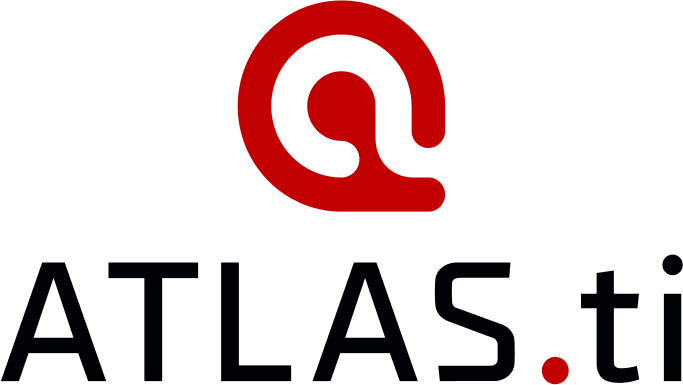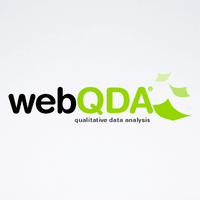Yes, most qualitative data analysis software is accessible across numerous devices and platforms. This enables researchers to work smoothly on data analysis from their computer, laptop, tablet, or even smartphone. Cloud-based solutions enable data to be accessed and collaborated on from any location with an internet connection. Whether you use Windows, Mac, or a mobile device, there are qualitative data analysis software solutions to meet your requirements.
List of Best Qualitative Data Analysis Software
ATLAS.ti is the leading QDA software designed to enhance qualitative research for both individuals and teams globally. Our user-friendly features allow for effortless uncovering of deep insights. We offer a complete package at a transparent price wit...Read More ATLAS.ti
QDA Miner Lite, a free version of our top-rated qualitative analysis software. This powerful tool is designed to assist in the analysis of text data, including open-ended responses, interview transcripts, and news articles. With the added feature of...Read More QDA Miner Lite
MAXQDA - the leading data analysis solution for qualitative and mixed methods research. Compatible with both Windows and Mac, MAXQDA is renowned for its top-notch features and global recognition. Unlock success in your research with the trusted and c...Read More MAXQDA
Quirkos - Your go-to solution for qualitative data analysis. Our user-friendly tool simplifies the process of organizing and interpreting text data. Utilize features such as tagging and coding to connect themes and identify patterns across various so...Read More Quirkos
LiveSession is a product analytics tool that offers detailed insights into user behavior. With its session replay and event-based analytics features, businesses can enhance their user experience, troubleshoot issues, and boost conversion rates. This...Read More LiveSession
GetWhy is insights platform that utilizes advanced AI technology to deliver exceptional consumer insights at an unbeatable cost. Our platform is the perfect all-in-one solution for all your research requirements, providing unparalleled speed and valu...Read More GetWhy
IBM SPSS Modeler: data mining and predictive analytics solution that enables businesses to uncover hidden patterns, leverage data for informed decision-making, and enhance operational efficiency. Its user-friendly interfaces and advanced machine lear...Read More IBM SPSS Modeler
DiscoverText is a text analysis software that simplifies data collection, organization, and classification. It seamlessly blends both human and machine-learning techniques, making it ideal for researchers, businesses, and legal teams dealing with lar...Read More DiscoverText
Qiqqa is a knowledge management solution to strengthen your customer connections. This robust platform offers a variety of tools, including collaboration features, advanced search capabilities, a self-service portal, streamlined knowledge-base manage...Read More Qiqqa
Dovetail is tool that harnesses user feedback to provide key insights for product development teams. By aggregating data from various sources, Dovetail reveals valuable patterns and trends to ensure products fulfill user expectations. With this infor...Read More Dovetail
NVivo is a qualitative data analysis software. Equipped with advanced coding, querying, and reporting capabilities, NVivo revolutionizes research by simplifying and enhancing data management, analysis, and visualization. With its comprehensive platfo...Read More NVivo
Transana is software that allows researchers to integrate and analyze various forms of data, such as video, audio, text, and images. With advanced capabilities like automated transcription and personalized reports, Transana simplifies the process of...Read More Transana
f4analyse is a qualitative data analysis software. With its user-friendly interface and multiple data export options, this software simplifies the data analysis process. Generate efficient code content and utilize the advanced hierarchy coding system...Read More f4analyse
webQDA - an online software designed to streamline your research process and produce precise data analysis. With its comprehensive tools, effortlessly compare different datasets and effortlessly integrate your findings. Discover a more efficient and...Read More webQDA
ITlytics is a data analytics and visualization solution that caters to a diverse range of industries and budgets. Our powerful platform enables businesses to adopt a data-driven approach, accessing valuable insights for informed decision-making. With...Read More ITLytics
Dedoose is a qualitative data analysis software that utilizes AI technology to enhance your research process. It gathers data from diverse sources and employs top-notch encryption for the utmost data security. With its futuristic features, Dedoose he...Read More Dedoose
Learn More About Qualitative Data Analysis Software
- What Is Qualitative Data Analysis Software?
- What Are The Recent Trends In Qualitative Data Analysis Software?
- Benefits Of Using Qualitative Data Analysis Software
- Important Factors To Consider While Purchasing Qualitative Data Analysis Software?
- What Are The Key Features To Look For In Qualitative Data Analysis Software?
- Why Do Businesses Need Qualitative Data Analysis Software?
- How Much Time Is Required To Implement Qualitative Data Analysis Software?
- What Is The Level Of Customization Available In Qualitative Data Analysis Software?
- Which Industries Can Benefit The Most From Qualitative Data Analysis Software?
- Conclusion
What Is Qualitative Data Analysis Software?
Qualitative data analysis software allows researchers and analysts to organize, investigate, and interpret non-numerical or unstructured data. This type of software is widely used in social sciences, market research, and other sectors where data is gathered via interviews, focus groups, surveys, and other methods that generate text or audio-visual data.
One of the primary purposes of qualitative data analysis software is to speed the data analysis process, which can be time-consuming and burdensome when carried out manually. These technologies enable researchers to rapidly code, categorize, and extract insights from massive volumes of qualitative data. Most qualitative data analysis software has capabilities that enable researchers to organize and annotate their data, visually track trends and themes, and generate reports and visualizations to convey their findings.
Some advanced software may also have natural language processing capabilities, which enable the automation of activities such as sentiment analysis and subject modeling. When selecting qualitative data analysis software, take into account your project's specific needs and research objectives. Some software may be more suited to in-depth coding and analysis, whereas others may emphasis data presentation and reporting. It is also critical to assess the software's compatibility with your data formats, as well as the learning curve required to operate the tool efficiently.
What Are The Recent Trends In Qualitative Data Analysis Software?
In recent years, qualitative data analysis software has seen a considerable surge in use across a variety of industries, including market research, education, and healthcare. This increase can be ascribed to the increased need for detailed and nuanced insights from qualitative data, as well as technological improvements that have made these tools more accessible and user-friendly.
One of the most prominent trends in qualitative data analysis software is the use of artificial intelligence and machine learning algorithms. These systems can now automatically process and categorize enormous amounts of qualitative data, freeing up researchers' time to focus on data interpretation and analysis. Furthermore, this technology allows software to recognize developing themes and patterns, which improves the accuracy and efficiency of qualitative data processing.
Another trend is the integration of visualization tools into qualitative data analysis software. Visual data representations, such as charts, maps, and diagrams, help users understand and convey their findings more effectively. This is especially beneficial for non-technical stakeholders who may struggle with text-heavy reports, as well as for visualizing complicated linkages and connections within the data.
Cloud-based solutions are also becoming more prominent in the field of qualitative data analysis. These enable users to access and collaborate on data analysis projects from anywhere, making it easier for teams to work remotely and share results with clients or colleagues. Cloud-based software also provides more security and data storage capabilities, making it a more convenient and dependable choice for research initiatives.
Finally, user-friendliness and intuitive design are becoming increasingly important in qualitative data analysis tools. This makes these tools more accessible to researchers who lack specialist technical abilities, allowing them to do complicated studies without requiring substantial training or help. As a result, qualitative data analysis software is becoming more user-friendly and inclusive, making its benefits accessible to a broader range of users.
Benefits Of Using Qualitative Data Analysis Software
Qualitative data analysis software is an invaluable resource for researchers, analysts, and enterprises dealing with non-numerical data. With its extensive capabilities and user-friendly design, this program simplifies the process of evaluating and understanding qualitative data, making it a crucial investment for any firm seeking insights and making sound decisions.
1. Streamlines Data Management: One of the key advantages of adopting qualitative data analysis software is that it simplifies data administration. This software allows you to easily import, organize, and store enormous volumes of data from multiple sources. Its sophisticated search and filter functions enable you to easily locate and retrieve specific data, removing the need for manual sorting and lowering the danger of human mistake.
2. Saves Time And Effort: Analyzing qualitative data can be a time-consuming and laborious process. However, with the help of software, this process can be greatly hastened. These technologies use powerful algorithms to automatically code, categorize, and analyze data, saving time and effort spent sifting through and making sense of massive amounts of information.
3. Improves Data Accuracy: Qualitative data analysis software also improves data analysis accuracy. With its strong coding and categorization capabilities, this program ensures that all data is accurately classified, eliminating the possibility of errors or omission. This, in turn, leads to more dependable and trustworthy insights, making it a valuable resource for both scholars and enterprises.
4. Offers Visual: Representation of Data Visual representations, such as charts, graphs, and mind maps, are extremely useful for illustrating patterns and correlations in data. With qualitative data analysis software, you can simply build these visual aids, which will help you obtain a better understanding of your data and convey your findings to others in a clear and succinct manner.
5. Provides Advanced Analytical Tools: Qualitative data analysis software includes advanced analytical capabilities such as text mining, sentiment analysis, and thematic analysis. These tools assist you in identifying underlying themes, patterns, and trends in your data, revealing deeper insights that may not be obvious at first glance.
6. Promotes Collaboration And Sharing: Collaboration is an essential component of data analysis, particularly in larger businesses where multiple teams may be working with the same data. Qualitative data analysis software allows you to easily share and participate on projects with team members, making it an invaluable tool for encouraging cooperation and information sharing within your organization.
Important Factors To Consider While Purchasing Qualitative Data Analysis Software?
When it comes to choosing qualitative data analysis software, there are numerous critical variables to consider. This type of software is required for organizing, understanding, and extracting insights from qualitative data, making it an important investment for many enterprises and researchers.
To make the best option for your individual needs, here are some critical elements to consider while assessing and selecting qualitative data analysis software:
1. Features And Functionality: The first and most significant considerations are the software's features and functionality. Make sure you properly evaluate the software's capabilities and compare them to your specifications. Some key features to look for are data visualization tools, coding options, auto-coding features, and the capacity to handle huge and complex datasets.
2. Usability: Because qualitative data analysis can be a complicated process, it is critical to pick software that is simple to use. Look for a user-friendly interface, simple and easy navigation, and useful tutorials and guidelines to help you learn and utilize the product efficiently.
3. Compatibility And Integration: It is also critical to evaluate how the program will interact with other systems and data sources. Check if the program is compatible with the file formats and data sources you regularly use, and think about how effectively it interfaces with your current data analysis tools.
4. Cost And Budget: When it comes to selecting software, the cost is always a significant factor. Look for a balance between cost and functionality, and consider the software's long-term usefulness rather than its initial cost. In addition, ask about any hidden expenditures, such as upgrades or maintenance fees, to avoid future surprises.
5. Customer Support And Training: Because qualitative data analysis software can be complicated, it is critical to have access to adequate customer support and training resources. Look for software that provides strong customer support, such as live chat, tutorials, and forums, and examine the availability and quality of training alternatives to ensure that you can get the most out of the product.
6. Security And Privacy: Given the growing concern about data security and privacy, it is critical to select software that emphasizes these factors. Look for software that provides data encryption, secure data storage, and compliance with relevant requirements like GDPR or HIPAA.
7. User Reviews And Recommendations: Finally, before making a final selection, conduct research and study user reviews and recommendations for the software under consideration. This can provide useful insights about the software's strengths and drawbacks, allowing you to make an informed selection.
What Are The Key Features To Look For In Qualitative Data Analysis Software?
Qualitative data analysis software is a must-have tool for researchers, corporations, and organizations seeking deep insights into non-numerical data. However, with so many options available, it might be difficult to select the proper program.
To make an informed decision, here are some important aspects to look for in qualitative data analysis software:
1. Compatibility And Usability: The program should work with a variety of operating systems and data formats to ensure easy integration with your current data. Furthermore, it should have an intuitive user interface that is simple to use for both novice and advanced users.
2. Data Management And Organization: The program should provide facilities for organizing, managing, and storing huge amounts of qualitative data in an organized and user-friendly format. This includes features like tagging, coding, and connecting data for easier analysis.
3. Data Visualization And Exploration: Look for software that has visual tools like charts, graphs, and maps to help you explore and analyze data more effectively. This can help you detect patterns, trends, and relationships in the data.
4. Text Analysis And Coding: The software should provide efficient text analysis with tools such as coding, word frequency analysis, and theme identification. It should also support many coding methods and provide comprehensive annotation features.
5. Collaboration And Sharing: If your project involves a group of academics, the software should support collaboration and sharing. This can feature live collaboration, version control, and the option to export data in multiple formats for easy sharing.
6. Quality Assurance: Look for software that has capabilities for inspecting and cleansing your data. This can help to eliminate inaccuracies and increase the reliability of your findings.
7. Customer Assistance And Training: A reputable software provider should offer thorough customer assistance, such as training materials and user guides. This allows you to get the most out of the software and troubleshoot any problems that may emerge.
By taking these main qualities into account, you may select the most appropriate qualitative data analysis software for your goals and budget. Use free samples, demos, and customer reviews to compare alternative options before making a purchase. Finally, the correct software will simplify your data analysis process, resulting in more precise and insightful outcomes.
Why Do Businesses Need Qualitative Data Analysis Software?
Qualitative data analysis software is an indispensable tool for firms of all sizes and sectors. It enables them to collect, organize, and understand vast amounts of non-numerical data in order to get significant insights and make sound judgments.
Here are a few reasons why firms use qualitative data analysis software:
1. Understand Customer Perception And Preferences: Qualitative data analysis software assists firms in understanding their customers' perceptions and preferences. By evaluating client feedback, reviews, and social media interactions, businesses can obtain a better knowledge of their target market and modify their products or services accordingly.
2. Spot Trends And Patterns: Qualitative data analysis software enables firms to spot developing trends and patterns in their industry or market. This enables them to keep ahead of the competition and make strategic business decisions.
3. Improve Product And Service Quality: Analyzing feedback and reviews allows organizations to find areas for improvement in their products or services. This not only increases consumer pleasure, but also improves the overall quality of their services.
4. Improve Marketing Strategies: Qualitative data analysis tools can help firms gain significant insights into customer behavior and preferences. This data can be utilized to improve and target marketing efforts, leading to more effective and successful campaigns.
5. Make Informed Business Judgments: By analyzing and interpreting qualitative data, firms may make evidence-based judgments rather than assumptions. This reduces hazards and improves the chances of success.
6. Save Time And Resources: Analyzing qualitative data manually takes time and resources. Businesses can use data analysis tools to streamline the process and save time and money, allowing them to focus on more critical areas of their operations.
How Much Time Is Required To Implement Qualitative Data Analysis Software?
The time required to develop qualitative data analysis software varies based on various aspects, including the data's complexity, dataset size, program capabilities, and user competence. On average, it can take between a few hours and several weeks to properly integrate and use qualitative data analysis tools. This involves the initial setup, data import and cleaning, becoming acquainted with the tools and procedures, and performing the analysis.
Users who are new to qualitative data analysis may need more time to become comfortable with the software and comprehend its possibilities. In contrast, experienced users may be able to implement the software more effectively and swiftly. In addition, the time necessary for execution is determined by the user's individual aims and research questions.
If the data is simple and the goals are well-defined, the implementation procedure may be faster than with a complicated dataset and ambiguous research objectives. It is critical to remember that the time spent on implementation has a direct impact on the quality and accuracy of the analysis. Rushing through the implementation process may result in errors and incorrect insights, but taking the time to understand and efficiently use the program can produce more solid and dependable outcomes.
What Is The Level Of Customization Available In Qualitative Data Analysis Software?
Qualitative data analysis software provides a variety of features and capabilities to help academics examine non-numerical data. However, one important feature that distinguishes different software is the degree of customization it provides to meet the individual needs and preferences of users. Buyers should examine the extent of customisation possible in software before purchasing.
Most qualitative data analysis software allows users to personalize many components of their analysis process, such as data entry, coding and categorization, visualization, and reporting. This allows researchers to tailor the software to their specific research topics, data kinds, and analytical approaches. The level of customisation provided varies substantially between different applications, so customers must carefully examine their requirements and compare various solutions.
Some software may have extensive customization choices, but others may have a more limited set of functionality. One issue to consider is the flexibility of data entry. Some software may let users to enter data in a variety of formats, including text, audio, and video, and then organize it in a way that best serves their study aims. This can involve generating new codes and categories, as well as the opportunity to add notes and memoranda for in-depth research.
Another critical part of customization is the coding and categorizing process. This entails organizing and classifying data to detect patterns and themes. varied software may provide varied coding structures and features, such as the ability to generate hierarchical or non-hierarchical codes, merge codes, and link codes to specific data segments. Visualization and reporting are also essential aspects of customisation.
Qualitative data analysis software should provide a variety of visualization tools, such as graphs, charts, and tables, to assist users in interpreting and presenting their results. Furthermore, the program should allow for the modification of report formats and layouts to meet the researcher's specific needs and preferences. Overall, the level of customisation offered by qualitative data analysis software can have a significant impact on the effectiveness and efficiency of the analysis process.
Buyers should thoroughly analyze their requirements and compare several software options to determine the greatest fit for their research objectives and methodologies.
Which Industries Can Benefit The Most From Qualitative Data Analysis Software?
Qualitative data analysis software is an invaluable resource for sectors that rely extensively on the collection and analysis of non-numerical data such as text, photos, and videos. This software enables businesses to extract useful insights from unstructured data, resulting in a better understanding of customer behavior, market trends, and overall business success.
Here are some of the industries that might benefit the most from employing qualitative data analysis software.
1. Market Research: firms can use qualitative data analysis software to collect and analyze customer insights. This software allows researchers to filter through enormous amounts of qualitative data from surveys, focus groups, and social media to find patterns and attitudes that may be used to guide marketing strategies and product development.
2. Healthcare: Qualitative data sources include patient comments, medical records, and clinical research, all of which can help healthcare businesses enhance their services and make more informed decisions. Qualitative data analysis tools can help determine patient requirements, preferences, and satisfaction levels, allowing healthcare professionals to modify their services accordingly.
3. Education: Qualitative data analysis software can be used to assess student performance, collect feedback, and improve instructional strategies. Teachers can use this program to examine student writings, surveys, and interviews to acquire insights into areas for growth and better understand their students' particular needs.
4. Government: Qualitative data analysis tools can be used by government organizations to assess citizen input, social media chats, and public surveys. This data can be used to guide policy decisions, track public mood, and pinpoint areas where government services can be improved.
5. Advertising And Marketing: Advertising and marketing organizations can use qualitative data analysis software to better understand consumer opinions, attitudes, and behaviors. It can assist agencies in identifying trends, preferences, and influencers, allowing them to design tailored advertisements that resonate with their target demographic.
Conclusion
Finally, when selecting the best qualitative data analysis software for your company or research needs, you should evaluate variables like as usability, data import and export capabilities, data visualization options, and customer support. Consider the exact features and tools that will be most useful for your project, such as coding and categorization, cross-platform compatibility, and collaboration possibilities.
Remember to evaluate the software's cost and price structure, as well as any potential limitations or restrictions on use. Reading reviews and seeking advice from coworkers or peers can also help you make an informed selection. Finally, the most appropriate qualitative data analysis software for you will be determined by your specific aims and requirements.
With the proper tools, you can swiftly and effectively evaluate your qualitative data, gaining useful insights to help you make decisions and move your organization ahead. We hope that this buyer's guide has helped you understand the important components of qualitative data analysis software and will assist you in selecting the best solution for your company.
Qualitative Data Analysis Software FAQ's
Can Qualitative Data Analysis Software Be Accessed Across Multiple Devices And Platforms?
Is Qualitative Data Analysis Software Future-Proof And Adaptable To Emerging Technologies Like AI, Blockchain Or IoT?
Qualitative data analysis software is continually changing to keep pace with new technology and trends. Many software packages are already using elements like machine learning and artificial intelligence to improve their capabilities.
Furthermore, as more data is collected through technologies such as IoT and blockchain, qualitative data analysis software will evolve and provide new ways to evaluate and interpret this data. So, certainly, this software is future-proof and can adapt to new technology.
Is There A Free Trial Offered To Assess Qualitative Data Analysis Software Before Committing?
Many qualitative data analysis software vendors provide a free trial period for potential clients to evaluate the product before making a purchase. This allows customers to test the software's features and functionalities to see if it satisfies their requirements. Some companies may provide a limited time trial, but others may supply a certain amount of data that can be analyzed during the trial. Make sure to use these free samples to make an informed decision.
Does Qualitative Data Analysis Software Offer Data Security Features And Meet Regulatory Compliance Standards?
Yes, most qualitative data analysis software includes data security safeguards and complies with regulatory requirements. These features include secured data storage, user authentication, and scheduled backups. Furthermore, many software vendors prioritize data security and continuously update their systems to comply with evolving standards. It is critical to select a reliable software provider and always check their security and compliance procedures before making a decision.
Can Qualitative Data Analysis Software Integrate Seamlessly With Existing Tools And Platforms?
Yes, most qualitative data analysis software products are intended to work easily with existing tools and platforms. These software solutions frequently allow for the easy import and export of data from other tools and platforms, making qualitative data analysis more efficient and simplified.
This integration also enables greater cooperation and data exchange among team members who use different tools or platforms. Overall, qualitative data analysis software aims to make data analysis as simple and user-friendly as feasible.


















